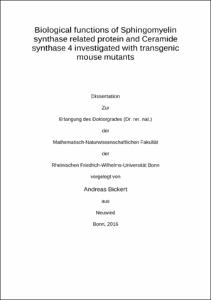Biological functions of Sphingomyelin synthase related protein and Ceramide synthase 4 investigated with transgenic mouse mutants

Biological functions of Sphingomyelin synthase related protein and Ceramide synthase 4 investigated with transgenic mouse mutants

| dc.contributor.advisor | Willecke, Klaus | |
| dc.contributor.author | Bickert, Andreas | |
| dc.date.accessioned | 2020-04-23T17:56:49Z | |
| dc.date.available | 2020-04-23T17:56:49Z | |
| dc.date.issued | 04.01.2017 | |
| dc.identifier.uri | https://hdl.handle.net/20.500.11811/7091 | |
| dc.description.abstract | Previously, it was reported that the catalytic activity of the sphingomyelin synthase related protein (SMSr) is essential to prevent ceramide accumulation and disruption of the early secretory pathway in cultured HeLa cells. The enzymatic product of SMSr is the sphingomyelin analog ceramide phosphoethanolamine (CPE). SMSr function was investigated in transgenic mice lacking SMSr catalytic activity. These mice were born according to Mendelian ratio with no obvious phenotypic abnormalities. Activity assays revealed that CPE synthase activity in brain primarily depends on SMSr and in liver to similar extent each on SMSr and sphingomyelin synthase 2 (SMS2). Immunoblot analyses revealed ubiquitous expression of SMSr with high levels in testis, brain and pancreas. Ultra-structural analysis of brain and liver cells showed no morphological abnormalities. Mass spectrometric analysis revealed no alterations in ceramide levels in ten different tissues. Wild type levels of CPE were exceedingly low in all investigated tissues. In mutant mice CPE levels were largely decreased in brain and to a minor extent in testis, kidney, spleen and lung. Surprisingly, combined inactivation of SMSr and SMS2 reduced, but did not eliminate tissue-specific CPE pools. Besides providing a comprehensive inventory of CPE and metabolizing enzymes, it was shown that SMSr is not a critical regulator of ceramide homeostasis in mice, as was suggested for cultured HeLa cells. SMSr-mediated CPE biosynthesis is dispensable for mouse development, vitality, fertility and survival. The second project focused on the function of ceramide synthase 4 (CerS4) in the development of diet-induced obesity. Previously, it was shown that loss of CerS5 or CerS6 protects mice from high fat diet-induced obesity due to a decrease in C16 ceramide in white adipose tissue (WAT), brown adipose tissue (BAT) or liver. In contrast, mice heterozygous for CerS2 were more susceptible to high fat diet-induced obesity due to an increase in C16 ceramide. In this study CerS4 deficient mice were protected from diet-induced obesity after exposure to high fat diet. This was characterized by reduced weight gain and improved glucose and insulin tolerance. Since CerS4 deficient mice suffer from a progressive hair loss, starting at the age of 6-7 weeks, it could not be excluded that beneficial effects result from increased energy expenditure initiated to compensate heat loss. However, 5 week old CerS4 deficient mice, showed no obvious signs of hair loss, but exhibited increased energy expenditure. The adipose tissue morphology in these mice suggested increased development of beige adipocytes, which similar to classical brown adipocytes are specialized in energy combustion for thermogenesis. In line with that, expression of thermogenic markers was increased in in vitro differentiated adipocytes from inguinal WAT of CerS4 deficient mice. The results indicate that CerS4 might be an attenuator of browning in WAT. | |
| dc.language.iso | eng | |
| dc.rights | In Copyright | |
| dc.rights.uri | http://rightsstatements.org/vocab/InC/1.0/ | |
| dc.subject | ceramide | |
| dc.subject | ceramide phosphoethanolamine | |
| dc.subject | diet-induced obesity | |
| dc.subject | browning | |
| dc.subject.ddc | 570 Biowissenschaften, Biologie | |
| dc.title | Biological functions of Sphingomyelin synthase related protein and Ceramide synthase 4 investigated with transgenic mouse mutants | |
| dc.type | Dissertation oder Habilitation | |
| dc.publisher.name | Universitäts- und Landesbibliothek Bonn | |
| dc.publisher.location | Bonn | |
| dc.rights.accessRights | openAccess | |
| dc.identifier.urn | https://nbn-resolving.org/urn:nbn:de:hbz:5n-45690 | |
| ulbbn.pubtype | Erstveröffentlichung | |
| ulbbnediss.affiliation.name | Rheinische Friedrich-Wilhelms-Universität Bonn | |
| ulbbnediss.affiliation.location | Bonn | |
| ulbbnediss.thesis.level | Dissertation | |
| ulbbnediss.dissID | 4569 | |
| ulbbnediss.date.accepted | 25.10.2016 | |
| ulbbnediss.institute | Mathematisch-Naturwissenschaftliche Fakultät : Fachgruppe Molekulare Biomedizin / Life & Medical Sciences-Institut (LIMES) | |
| ulbbnediss.fakultaet | Mathematisch-Naturwissenschaftliche Fakultät | |
| dc.contributor.coReferee | Hoch, Michael |
Files in this item
This item appears in the following Collection(s)
-
E-Dissertationen (4117)




